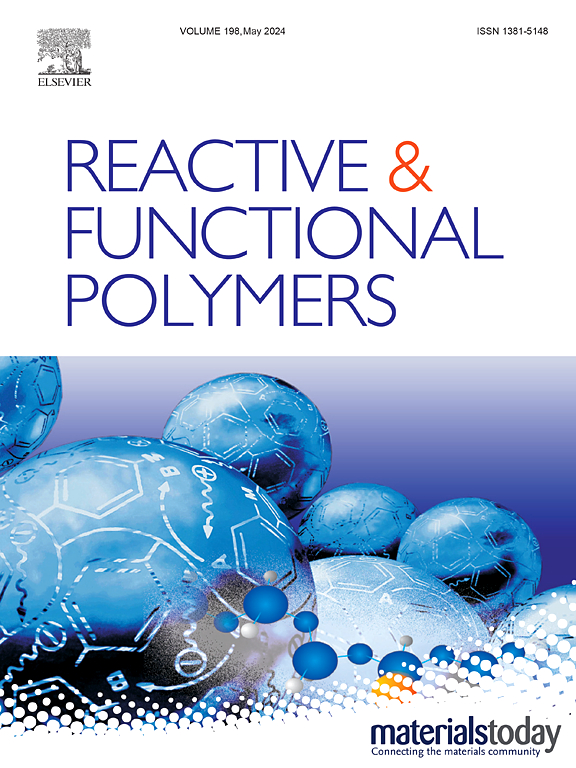Diels-Alder click化学工程离子印迹聚合物,用于从水溶液中高选择性地提取Gd3+
IF 5.1
3区 工程技术
Q1 CHEMISTRY, APPLIED
引用次数: 0
摘要
由于钆(Gd3+)离子的工业利用和环境风险日益增加,从水溶液中选择性去除和回收是至关重要的。本文以2-羟基-5-[(呋喃-2-甲基)氨基]苯并肼(FBH)为螯合功能,制备了聚丙烯腈(PAN)衍生的离子印迹聚合物(Gd-IIP)。通过亲核加成将FBH固定在dvb交联的PAN微球中,随后与双(马来酰)乙烷(BM)进行diols - alder (DA)交联,合成稳定和选择性的Gd3+结合位点。通过FTIR, XPS, SEM, XRD, BET和固态13C NMR表征证实了功能化。吸附研究表明,Gd-IIP在pH 6.0时具有较高的选择性和吸附量(448 mg/g),超过了非印迹聚合物(NIP)。对竞争离子(Ni2+, Cu2+, Co2+, Y3+, Dy3+, Ce3+)的选择性研究表明,Gd-IIP对Gd3+具有优越的亲和力,其选择性因子(βGd3+/Mn+)和相对选择性(βr)值超过30,证实了对离子的精确识别。动力学模型和等温模型显示为准二级吸附,Sips模型最适合。再生研究表明,经过5次循环后,吸附保留率超过97%,证实了其可重复使用和废水处理的效率。本文章由计算机程序翻译,如有差异,请以英文原文为准。

Diels-Alder click chemistry-engineered ion-imprinted polymer for highly selective Gd3+ extraction from aqueous solutions
The selective removal and recovery of gadolinium (Gd3+) ions from aqueous solutions are vital owing to their growing industrial utilization and environmental risks. In the present work, a polyacrylonitrile (PAN)-derived ion-imprinted polymer (Gd-IIP) was developed by using 2-Hydroxy-5-[(furan-2-ylmethyl)amino]benzohydrazide (FBH) as a chelating function. FBH was immobilized in DVB-crosslinked PAN microspheres by nucleophilic addition followed by subsequent Diels-Alder (DA) cross-linking with bis(maleimido)ethane (BM) for the synthesis of stable and selective Gd3+ binding sites. Functionalization was confirmed by characterization by FTIR, XPS, SEM, XRD, BET, and solid-state 13C NMR. Adsorption studies showed that Gd-IIP demonstrated high selectivity and adsorption capacity (448 mg/g) at pH 6.0, which exceeded the non-imprinted polymer (NIP). Selectivity studies against competing ions (Ni2+, Cu2+, Co2+, Y3+, Dy3+, and Ce3+) demonstrated Gd-IIP's superior affinity for Gd3+, with selectivity factor (βGd3+/Mn+) and relative selectivity (βr) values exceeding 30, confirming precise ion recognition. Kinetic and isothermal modeling indicated pseudo-second-order adsorption, with the Sips model as the best fit. Regeneration studies showed over 97 % adsorption retention after five cycles, confirming its reusability and efficiency for wastewater treatment.
求助全文
通过发布文献求助,成功后即可免费获取论文全文。
去求助
来源期刊

Reactive & Functional Polymers
工程技术-高分子科学
CiteScore
8.90
自引率
5.90%
发文量
259
审稿时长
27 days
期刊介绍:
Reactive & Functional Polymers provides a forum to disseminate original ideas, concepts and developments in the science and technology of polymers with functional groups, which impart specific chemical reactivity or physical, chemical, structural, biological, and pharmacological functionality. The scope covers organic polymers, acting for instance as reagents, catalysts, templates, ion-exchangers, selective sorbents, chelating or antimicrobial agents, drug carriers, sensors, membranes, and hydrogels. This also includes reactive cross-linkable prepolymers and high-performance thermosetting polymers, natural or degradable polymers, conducting polymers, and porous polymers.
Original research articles must contain thorough molecular and material characterization data on synthesis of the above polymers in combination with their applications. Applications include but are not limited to catalysis, water or effluent treatment, separations and recovery, electronics and information storage, energy conversion, encapsulation, or adhesion.
 求助内容:
求助内容: 应助结果提醒方式:
应助结果提醒方式:


